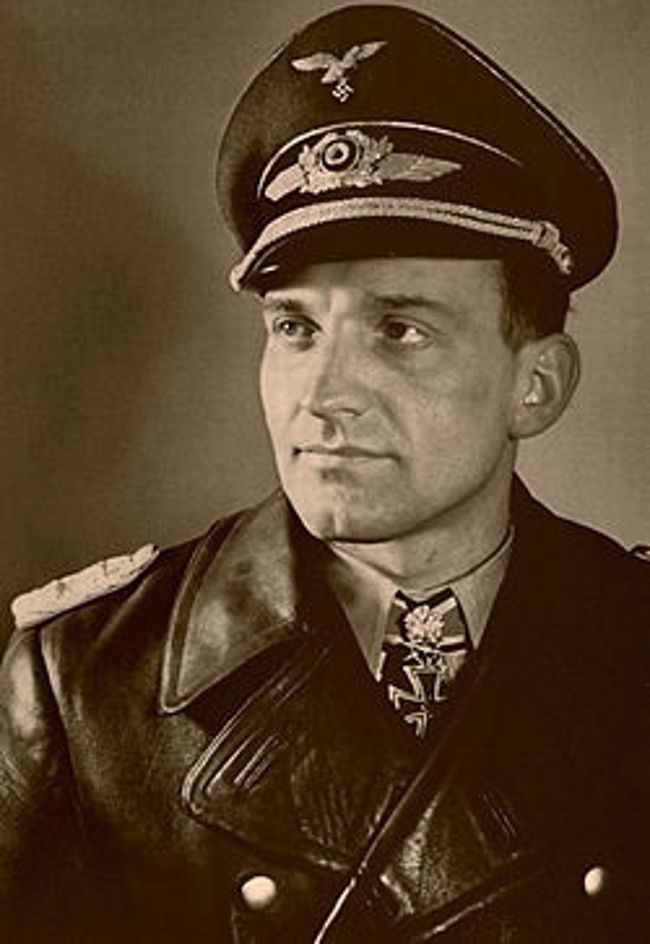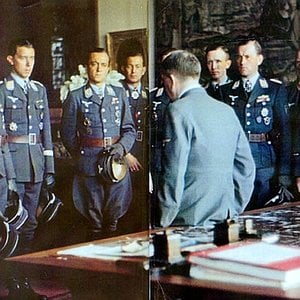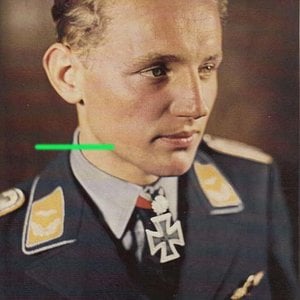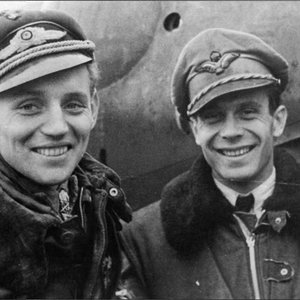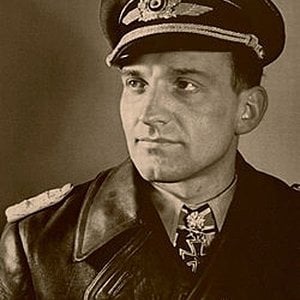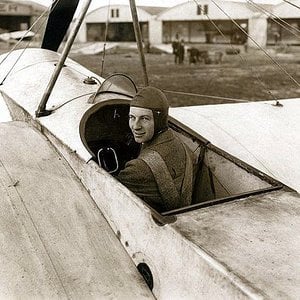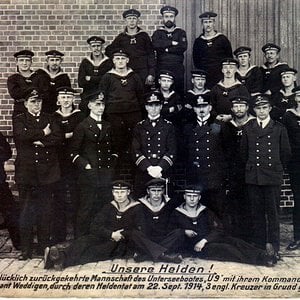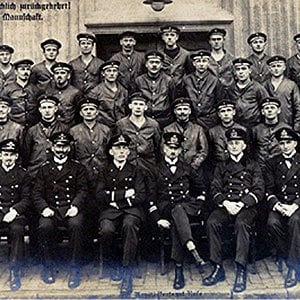Navigation
Install the app
How to install the app on iOS
Follow along with the video below to see how to install our site as a web app on your home screen.
Note: This feature may not be available in some browsers.
More options
You are using an out of date browser. It may not display this or other websites correctly.
You should upgrade or use an alternative browser.
You should upgrade or use an alternative browser.
Biography
Rudel, the son of Lutheran minister Johannes, was born in Konradswaldau (Silesia), Germany. He was raised in a number of different Silesian parishes. As a boy he was a poor scholar but a very keen sportsman. In August 1936, after his Abitur (University-preparatory high school diploma), he joined the Luftwaffe as an officer cadet, and began basic training at the "School of Air Warfare" at Wildpark-Werder.
In June 1938 he joined I./Sturzkampfgeschwader 168 in Graz as an officer senior cadet. Rudel had difficulty learning the new techniques and was considered unsuitable for combat flying, so on 1 January 1939, he was transferred to the Reconnaissance Flying School at Hildesheim for training in operational reconnaissance. He was promoted to Leutnant (Second Lieutenant) on that date.[2] After completing training he was posted to the Fernaufklärungsgruppe 121 (Long-Range Reconnaissance Group) at Prenzlau.
Rudel was a teetotaler and non-smoker. His fellow pilots coined the phrase Hans-Ulrich Rudel, er trinkt nur Sprudel (Hans-Ulrich Rudel, he drinks only sparkling water).
[edit] World War II
During the Polish Campaign at the start of World War II, he flew (as an observer) on long-range reconnaissance missions over Poland from Breslau. Rudel earned the Iron Cross 2nd Class on 11 October 1939. After a number of requests he was reassigned to dive bombing, joining an Aviation Training Regiment at Crailsheim and then he was assigned to his previous unit, I./Sturzkampfgeschwader 3 (StG 3),[Note 2] at Caen in May 1940. He spent the Battle of Britain as an Oberleutnant (First Lieutenant) in a non-combat role. Still regarded as a poor pilot, he was sent to a Reserve Flight at Graz for dive bombing training. Assigned to I./Sturzkampfgeschwader 2 (StG 2), based at Molaoi, his poor reputation, by then unjustified, preceded him and he also spent the invasion of Crete in a non-combat role.
Ju 87 G-2 "Kanonenvogel" with its twin Bordkanone BK 3.7, 37 mm guns.
Menu
0:00
Rudel in German newsreel
Rudel flew his first four combat missions on 23 June 1941, during the German invasion of the Soviet Union. His demonstrated piloting skills earned him the Iron Cross 1st Class on 18 July 1941. On 23 September 1941, he and another Stuka pilot sank the Soviet battleship Marat, during an air attack on Kronstadt harbor in the Leningrad area, with hits to the bow using 1,000 kg bombs.[3] By the end of December, he had flown his 400th mission and in January 1942 received the Knight's Cross of the Iron Cross. On 10 February 1943, he became the first pilot in history to fly 1,000 sorties. Around this time he also started flying anti-tank operations with the 'Kanonenvogel', or G, version of the Ju-87, through the Battle of Kursk, and into the autumn of 1943, claiming 100 tanks destroyed.
By March 1944, he was already Gruppenkommandeur (group commander) of III./StG 2 (appointed on 19 July 1943) and had reached 1,800 operations. At that time he claimed 202 tanks destroyed.
On 13 March 1944 Rudel may have been involved in aerial combat with the Hero of the Soviet Union, Lev Shestakov. Shestakov failed to return from this mission and was posted as missing in action. From Rudel's memoirs:
Was he shot down by Gadermann [Rudel's rear gunner], or did he go down because of the backwash from my engine during these tight turns? It doesn't matter. My headphones suddenly exploded in confused screams from the Russian radio; the Russians have observed what happened and something special seems to have happened... From the Russian radio-messages, we discover that this was a very famous Soviet fighter pilot, more than once appointed as Hero of the Soviet Union. I should give him credit: he was a good pilot.
In November 1944, he was wounded in the thigh and flew subsequent missions with his leg in a plaster cast.
On 8 February 1945, a 40 mm shell hit his aircraft. He was badly wounded in the right foot and crash landed inside German lines. His life was saved by his observer Ernst Gadermann who stemmed the bleeding, but Rudel's leg was amputated below the knee. He returned to operations on 25 March 1945, claiming 26 more tanks destroyed before the end of the war. Determined not to fall into Soviet hands, he led three Ju 87s and four FW 190s westward from Bohemia in a 2-hour flight. Landing at Kitzingen airfield, held by the US 405th Fighter Group, Rudel had his men lock the brakes and collapse the landing gear to make the aircraft useless to the Americans and to render the airfield unusable by blocking the airstrip. Then he surrendered to U.S. forces, on 8 May 1945.
Eleven months in prisoner of war camps followed. Released by the Americans, he moved to Argentina in 1948.
[edit] Achievements
According to official Luftwaffe figures, Rudel flew some 2,530 combat missions (a world record).[Note 3] He was never shot down by another pilot, only by anti-aircraft artillery. He was shot down or forced to land 32 times, several times behind enemy lines.
Nickname
Eagle of the Eastern Front
Born
2 July 1916
Konradswaldau, Germany
Died
18 December 1982 (aged 66)
Rosenheim, Germany
Buried at
Dornhausen, near Gunzenhausen
Allegiance
Nazi Germany
Service/branch
Luftwaffe
Years of service
1936–1945
Rank
Oberst (Colonel)
Unit
StG 3, StG 2, SG 2
Commands held
III./StG 2, SG 2
Battles/wars
World War II
Eastern Front
Battle of Kursk
Awards
Knight's Cross of the Iron Cross with Gold Oak Leaves, Swords and Diamonds
Other work
Writer, Businessman, member of the German Reich Party
Rudel, the son of Lutheran minister Johannes, was born in Konradswaldau (Silesia), Germany. He was raised in a number of different Silesian parishes. As a boy he was a poor scholar but a very keen sportsman. In August 1936, after his Abitur (University-preparatory high school diploma), he joined the Luftwaffe as an officer cadet, and began basic training at the "School of Air Warfare" at Wildpark-Werder.
In June 1938 he joined I./Sturzkampfgeschwader 168 in Graz as an officer senior cadet. Rudel had difficulty learning the new techniques and was considered unsuitable for combat flying, so on 1 January 1939, he was transferred to the Reconnaissance Flying School at Hildesheim for training in operational reconnaissance. He was promoted to Leutnant (Second Lieutenant) on that date.[2] After completing training he was posted to the Fernaufklärungsgruppe 121 (Long-Range Reconnaissance Group) at Prenzlau.
Rudel was a teetotaler and non-smoker. His fellow pilots coined the phrase Hans-Ulrich Rudel, er trinkt nur Sprudel (Hans-Ulrich Rudel, he drinks only sparkling water).
[edit] World War II
During the Polish Campaign at the start of World War II, he flew (as an observer) on long-range reconnaissance missions over Poland from Breslau. Rudel earned the Iron Cross 2nd Class on 11 October 1939. After a number of requests he was reassigned to dive bombing, joining an Aviation Training Regiment at Crailsheim and then he was assigned to his previous unit, I./Sturzkampfgeschwader 3 (StG 3),[Note 2] at Caen in May 1940. He spent the Battle of Britain as an Oberleutnant (First Lieutenant) in a non-combat role. Still regarded as a poor pilot, he was sent to a Reserve Flight at Graz for dive bombing training. Assigned to I./Sturzkampfgeschwader 2 (StG 2), based at Molaoi, his poor reputation, by then unjustified, preceded him and he also spent the invasion of Crete in a non-combat role.
Ju 87 G-2 "Kanonenvogel" with its twin Bordkanone BK 3.7, 37 mm guns.
Menu
0:00
Rudel in German newsreel
Rudel flew his first four combat missions on 23 June 1941, during the German invasion of the Soviet Union. His demonstrated piloting skills earned him the Iron Cross 1st Class on 18 July 1941. On 23 September 1941, he and another Stuka pilot sank the Soviet battleship Marat, during an air attack on Kronstadt harbor in the Leningrad area, with hits to the bow using 1,000 kg bombs.[3] By the end of December, he had flown his 400th mission and in January 1942 received the Knight's Cross of the Iron Cross. On 10 February 1943, he became the first pilot in history to fly 1,000 sorties. Around this time he also started flying anti-tank operations with the 'Kanonenvogel', or G, version of the Ju-87, through the Battle of Kursk, and into the autumn of 1943, claiming 100 tanks destroyed.
By March 1944, he was already Gruppenkommandeur (group commander) of III./StG 2 (appointed on 19 July 1943) and had reached 1,800 operations. At that time he claimed 202 tanks destroyed.
On 13 March 1944 Rudel may have been involved in aerial combat with the Hero of the Soviet Union, Lev Shestakov. Shestakov failed to return from this mission and was posted as missing in action. From Rudel's memoirs:
Was he shot down by Gadermann [Rudel's rear gunner], or did he go down because of the backwash from my engine during these tight turns? It doesn't matter. My headphones suddenly exploded in confused screams from the Russian radio; the Russians have observed what happened and something special seems to have happened... From the Russian radio-messages, we discover that this was a very famous Soviet fighter pilot, more than once appointed as Hero of the Soviet Union. I should give him credit: he was a good pilot.
In November 1944, he was wounded in the thigh and flew subsequent missions with his leg in a plaster cast.
On 8 February 1945, a 40 mm shell hit his aircraft. He was badly wounded in the right foot and crash landed inside German lines. His life was saved by his observer Ernst Gadermann who stemmed the bleeding, but Rudel's leg was amputated below the knee. He returned to operations on 25 March 1945, claiming 26 more tanks destroyed before the end of the war. Determined not to fall into Soviet hands, he led three Ju 87s and four FW 190s westward from Bohemia in a 2-hour flight. Landing at Kitzingen airfield, held by the US 405th Fighter Group, Rudel had his men lock the brakes and collapse the landing gear to make the aircraft useless to the Americans and to render the airfield unusable by blocking the airstrip. Then he surrendered to U.S. forces, on 8 May 1945.
Eleven months in prisoner of war camps followed. Released by the Americans, he moved to Argentina in 1948.
[edit] Achievements
According to official Luftwaffe figures, Rudel flew some 2,530 combat missions (a world record).[Note 3] He was never shot down by another pilot, only by anti-aircraft artillery. He was shot down or forced to land 32 times, several times behind enemy lines.
Nickname
Eagle of the Eastern Front
Born
2 July 1916
Konradswaldau, Germany
Died
18 December 1982 (aged 66)
Rosenheim, Germany
Buried at
Dornhausen, near Gunzenhausen
Allegiance
Nazi Germany
Service/branch
Luftwaffe
Years of service
1936–1945
Rank
Oberst (Colonel)
Unit
StG 3, StG 2, SG 2
Commands held
III./StG 2, SG 2
Battles/wars
World War II
Eastern Front
Battle of Kursk
Awards
Knight's Cross of the Iron Cross with Gold Oak Leaves, Swords and Diamonds
Other work
Writer, Businessman, member of the German Reich Party

